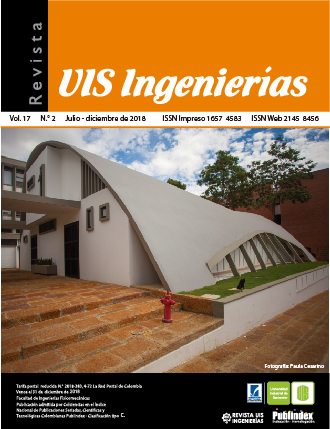Environmental assessment related to the sewage water discharge of a tannery company into Aburra river
Published 2018-06-12
Keywords
- Affectation,
- impact,
- load,
- modeling,
- organic matter
- watershed ...More
How to Cite
Abstract
Tannery industries use organic and inorganic chemicals to perform their operations by generating pollutant discharges that are discharged to surface sources. This study evaluated the environmental impact associated with the dumping of a tannery company located in the Municipality of Copacabana, Antioquia, characterizing the area of direct and indirect influence affected by the company's discharges in to river Aburrá. The Conesa method was applied (based on the cause-effect matrix method involving the Leopold matrix and the Batelle-Columbus Institute method). According to the results, it was possible to identify as a significant impact as a significant impact the use and physicochemical alteration of water resources, especially in the tanning process related to soaking, hair removal, dewatering, purging, pickling, tanning, retanning and dyeing.The parameters of pH, Conductivity, BOD (fast and slow), flow rate and temperature using the QUAL2K model of the EPA were simulated in order to verify the impact of the discharge of the company's spills on the water source.In this study, it was determined that the rapid BOD discharged increases the concentration of 167 mg O2/L up to 185 mg O2 /L in the studied section, moving significantly away from the quality objective of the Aburra river of 50 mg O2/L and exceeding the limits permissible in Resolution 631 of 2015 in the parameters COD and BOD5, by 203% and 150%. The parameters of Conductivity and temperature did not show affectation in the source.
Downloads
References
www.sirac.info/curtiembres/html/archivos/publicaciones/estratagiasdiagnostico.pdf
CONESA, V. Guía metodológica para la evaluación de impacto ambiental. Ed. Mundi- Prensa 3ra edición, Madrid 2003. ISBN 84-7114-647-9
CABALLERO ESCRIBANO, C. Historia de los curtidos de las pieles. Alicante, España: Editorial Club Universitario 2013. ISBN 97-8849-948-749-6
LOFRANO, Giusy, et al. Chemical and biological treatment technologies for leather tannery chemicals and wastewaters: A review. En: SCIENCE OF THE TOTAL ENVIRONMENT. Septiembre, 2013. vol. 461–462, p. 265-281
MINISTERIO DE AMBIENTE, VIVIENDA Y DESARROLLO TERRITORIAL. Guía ambiental para la industria del curtido y preparado de cueros. Segunda Edición ed. Bogotá D.C.: Print Digital Ltda 2006. ISBN 9789589778548
MCCANN, M. Capítulo 88 Cuero, pieles y calzado. En: enciclopedia de la OIT. D - INSHT (Instituto Nacional de Seguridad e Higiene en el Trabajo) 2012.
SALAS, G. Eliminación de sulfuros por oxidación en el tratamiento del agua residual de una curtiembre. Revista Peruana de Química e Ingeniería Química. Vol. 8 N.º 1 2005. Inline ISSN. 1609-7599. PrintISSN: 1726-2208
CARABIAS, J; PROVENCIO, E y CORTINAS, C. Manual de Procedimientos para el Manejo Adecuado de los Residuos de la Curtiduría. Primera Edición ed. México D.F.: Instituto Nacional de Ecología 1999.
COOMAN, K., et al. Tannery wastewater characterization and toxicity effects on Daphnia spp. En: Environmental Toxicology. vol. 18, No. 1, p. 45-51. 2003 https://doi.org/10.1002/tox.10094
ALOY, M.; FOLACHIER, A. y VULLIERMET, B. Tannery and pollution. Lyon (France): Centre Technique du Cuir. 306 p. 1976.
THANIKAIVELAN, P.; RAO, J. R. y NAIR, B. U. Development of leather processing method in narrow pH profile. Part 1: standardization of dehairing process, vol. 84, no. 6, p. 276-284. 2000.
MARSAL, A., et al. Oxidizing unhairing process with hair recovery. Part I: experiments on the prior hair immunization. vol. 83, No. 47, p. 310-315. 1999.
ARANGO, C. Proyecto Gestión Ambiental en la Industria de Curtiembre en Colombia. Colombia. p. 5. 2004
CONESA, V. Guía metodológica para la evaluación de impacto ambiental. Ed. Mundi- Prensa 3ra edición, Madrid. ISBN 84-7114-647-9. 2003
ÁREA METROPOLITANA DEL VALLE DE ABURRÁ. Red de monitoreo ambiental en la cuenca hidrográfica del río Aburrá en jurisdicción del área. convenio 368 de 2014 – adición I y II metropolitana. Septiembre 2016
http://www.metropol.gov.co/recursohidrico/Documents/ParametrosCalidadRio/EstacionesAutomaticasMonitoreoAguaSuperficial.pdf. Consultado el 12 de septiembre de 2017
UNIVERSIDAD DE ANTIOQUIA, et al. Red de monitoreo ambiental en la cuenca hidrográfica del río Aburrá - Medellín en jurisdicción del Área Metropolitana FASE IV - Informe de calidad. Medellín. p. 1249-1255. 2014.
DIAZ, B. Modelación de la calidad del agua en el interceptor río Bogotá en los tramos Fucha-Tunjuelo-Canoas. Universidad De Los Andes, 2004. p. 15-18
O. Guarín-Villamizar, “Metodología para evaluación de la condición ambiental en microcuencas urbanas,” Rev. UIS Ing., vol. 16, no. 2, pp. 141-150, 2017. Doi: https://doi.org/10.18273/revuin.v16n2-2017013

